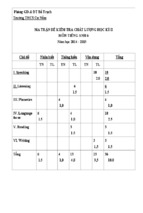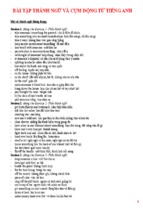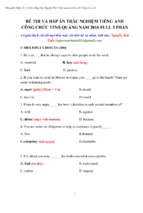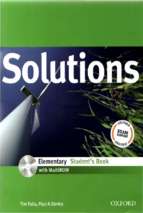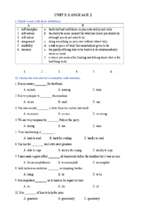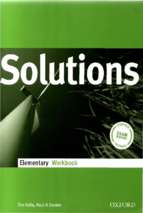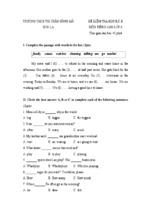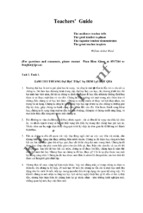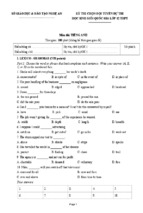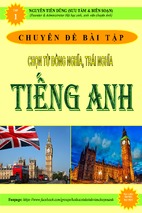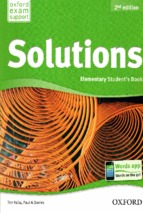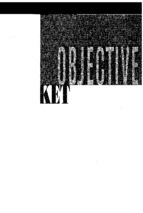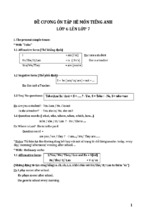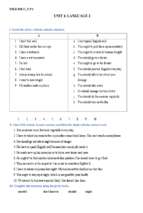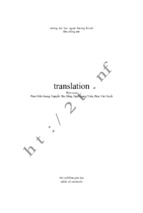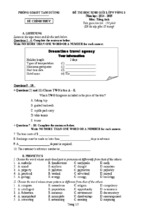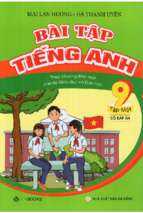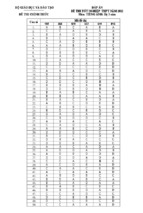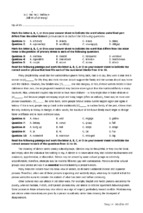CÁC DẠNG CÂU HỎI THƯỜNG GẶP
Theo xu hướng ra đề thi của Bộ GD&ĐT, bài tập đọc hiểu bao gồm những dạng bài tập sau:
1. Câu hỏi từ vựng (vocabulary questions)
2. Câu hỏi về nội dung chi tiết trong đoạn văn (details in the paragraph)
3. Câu hỏi suy luận (inference and reasoning questions)
4. Câu hỏi ý chính toàn đoạn (main idea questions)
Bốn loại câu hỏi trên được chúng tôi sắp xếp theo độ khó tăng dần và các bạn nên chinh phục bài đọc hiểu theo thứ
tự này. Sau đây chúng ta hãy cùng phần tích kỹ từng dạng câu hỏi nhé!!!
Dạng 1: Từ vựng trong văn cảnh.
Đừng tự ti hay nhụt chí nếu như bạn gặp phải từ vựng mới, lạ, không hề xuất hiện trong trí nhớ của bạn. Hãy bình
tĩnh nhé vì đây là bài thi đọc hiểu mà và nếu xét về bản chất thì mọi câu hỏi đều được thiết kế với mục đích kiểm tra
khả năng đọc hiểu của bạn.
Các bước giải quyết:
1.Finding - Xác định vị trí từ vựng: thường thì từ vựng trong câu hỏi sẽ được in đậm trong bài văn cho nên bạn sẽ
không gặp khó khăn gì trong việc tìm kiếm chúng đâu.
2. Reading and Understanding – Đọc và hiểu: Dạng câu hỏi này thực sự đơn giản hơn nhiều so với những dạng khác
vì bạn chỉ cần đọc câu văn chứa từ vựng đó hoặc từ một đến hai câu xung quanh để hiểu được ý nghĩa của từ vựng.
3. Eliminating or Choosing – Loại bỏ và Chọn lựa: Sau khi hiểu được ý nghĩa và sắc thái của từ vựng, bạn có thể
loại bỏ ngay những từ không phù hợp. Ví dụ bạn suy luận được là từ vựng này mang nghĩa tích cực thì hay gạch bỏ
ngay những đáp án mang tính tiêu cực.
Hãy cùng chúng tôi xem xét một ví dụ sau trong đề thi THPT quốc gia năm 2015:
“Ocean ecosystem, especially “ABC” ones like coral reefs, will also be affected by global warming”
A. pretty hard
B. very large
C. rather strong D. easily damaged
Nhiều bạn được trang bị kiến thức tốt có thể xác định nghĩa của từ dựa vào cấu trúc từ: tiền tố (prefix), gốc từ (root)
và hậu tố (suffix). Thế nhưng không phải ai cũng nắm được những quy luật này và nói đòi hỏi kinh nghiệm cũng như
vốn từ khá rộng. Phương pháp sau đây dành cho những bạn có vốn từ trung bình với tham vọng chinh phục bài tập
dọc hiểu, các bạn cùng dịch với mình nhé:
“Một hệ thống gì đó (hệ sinh thái) của đại dương, ví dụ điển hình là những vật gì đó (rặng san hô) có đặc điểm “ABC”,
cũng sẽ bị ảnh hưởng bởi sự nóng lên toàn cầu.”
Các bạn có thể xác định ngay đây là một tính từ. Những rặng san hô này mang một tính chất nào đó khiến cho nó sẽ
bị ảnh hưởng bởi hiện tượng tự nhiên này. Lý do khiến cho nó bị ảnh hưởng, bị tác động thì không thể nào mang
nghĩa tích cực được. Ví dụ như nếu bạn sở hữu một cơ thể yếu đuối thì bệnh tật rất dễ tác động hay ảnh hưởng đến
bạn. Do vậy ta suy luận được “ABC” mang nghĩa tiêu cực và là điểm yếu của san hô.
Các đáp án: A (khá cứng, chắc), B (rất rộng), và C (khá khỏe mạnh) mang nghĩa tích cực nên chúng ngay lập tức
bị gạch bỏ. Và đáp án của chúng ta là D (dễ bị phá hủy, hủy hoại)
Các bạn thấy đó, chả cần biết đó là từ gì, hình dáng, mặt mũi nó trông ra sao mà ta vẫn có thể trả lời chính xác câu
hỏi này. Chinh phục câu hỏi từ vựng theo văn cảnh không hề khó và chúng tôi khuyên các bạn nên làm dạng này đầu
tiêu khi bắt tay vào làm bài đọc hiểu.
MỞ RỘNG (dành cho những ai thắc mắc và thấy hứng thú với phương pháp xác định cấu trúc từ mà mình nói ở
trên):
3
http://tuhocdotpha.megabook.vn/
“ABC” = FRAGILE = easily broken or damaged or destroyed
Với vốn từ khá rộng, các bạn có thể liên tưởng tiền tố FRA với những từ như Fragment (mảnh vỡ nhỏ), frail (yếu
ớt), fraction (phần nhỏ trong tổng thế)… Nhìn chung thì từ này tạo cảm giác nhỏ bé, vụn vặt, yếu đuối. Và chúng ta
có thể đoán được phần nào đáp án chính xác của câu hỏi này với những liên tưởng đơn giản như trên.
Dạng 2: Câu hỏi về nội dung chi tiết trong đoạn văn
Giải quyết xong câu hỏi từ vựng thì vấn đề bắt đầu trở nên phức tạp hơn, nhưng chỉ một chút thôi. Trong phần này,
câu hỏi đề cập đến một nội dung trong bài đọc và có thể được dẫn dắt như sau:
According to the passage…
It is stated in the passage...
The passage indicates that…
Which of the following is true/false...?
Đáp án của câu hỏi chắc chắn nằm trong đoạn văn, công việc của bạn là định vị nó và đọc thật kỹ trước khi lựa chọn
đáp án đúng. Trong câu này chúng ta vẫn áp dụng ba bước cơ bản: Finding – Reading and Understanding – Eliminating
and Choosing.
Khó khăn: để phân loại thí sinh, từ khóa (key words) trong đề bài thường được thể hiện dưới dạng đồng nghĩa với
nội dung trong bài. Do đó các bạn không nên mất thời gian tìm kiếm một các máy móc trong cả một bài đọc 400 đến
500 chữ. Bước 1 – Finding bao gồm việc hiểu nội dung câu hỏi trước khi bắt đầu tìm kiếm.
Ví dụ minh họa:
“Students can find out how fast they read by a simple method. First, they should count all the words on a page of a
book. Then, they read the page as they time themselves. After finishing reading, they should divide the number of
words read by the number of minutes spent reading.”
According to the passage, what is the first step in determining your reading speed?
a. Timing yourself as you read the page of a book
b. Dividing the number of words read by the number of minutes used.
c. Counting the number of words on a page
d. Determining if you need to read faster
Hãy để ý những từ được gạch chân, đó chính là từ khóa. Từ reading speed có thể không xuất hiện trong toàn bài văn,
do đó chúng ta phải hiểu rõ nội dung câu hỏi. Có có hai MANH MỐI cần làm rõ trước khi bước vào công cuộc tìm
kiếm
1. Phần nào nêu lên các bước? Các bước sẽ được thể hiện như thế nào? Sử dụng từ nối cơ bản nào?
2. Tốc độ đọc.
Với việc hiểu rõ yêu cầu đề bài, bạn sẽ tiết kiệm rất nhiều thời gian tìm kiếm và trả lời câu hỏi chính xác, đúng trọng
tâm với tốc độ nhanh chóng.
Dạng 3: Câu hỏi suy luận
4
http://tuhocdotpha.megabook.vn/
TOPIC 2: ENTERTAINMENT
Exercise 1: Mass media [●○○]
Most of us tend to think of production when we think of mass media industries. After all, it is the output of
this production – the papers we read, the cable TV shows we watch – that grab our attention, make us happy or angry,
interested or bored. Moreover, most public discussion about mass communication tends to be about production. The
latest gossip about that actor will be in what film, the angry comments a mayor makes about the violence on local TV
news, the newest CDs by an up-and-coming group – these are the kinds of topics that focus our attention on the
making of content, not its distribution or exhibition.
Media executives know, however, that production is only one step in the arduous and risky process of getting
a mass media idea to an audience. Distribution is the delivery of the produced material to the point where it will be
shown to its intended audience. The activity takes place out of public view. We have already mentioned the NBC acts
as a distributor when it disseminates television programming via satellite to TV stations. When Philadelphia
Newspapers Inc. delivers its Philadelphia Inquirer to city newsstands, when Twentieth – Century – Fox moves its
Musicland stores, they are involved in distribution to exhibitions.
Question 1. In this passage, “arduous” means________.
A. difficult
B. lucrative
C. lengthy
D. free
Question 2. The passage states that people tend to focus on production because _______.
A. it takes place out of public view
B. mass media companies do not own production divisions
C. the output of mass media is intended to grab our attention
D. companies can function as both producers and distributors
Question 3. In this passage, to “disseminate” means to _______.
A. create
B. send out
C. take in
D. fertilize
Question 4. This passage states that distribution is_______.
A. the first step in mass media production
B. the most talked-about step in mass media production
C. at least as important as production
D. not as important as exhibition
Question 5. The author’s purpose in writing this passage is to ________.
A. tell an interesting story
B. define a concept clearly
C. describe a scene vividly
D. argue with the reader
ĐÁP ÁN
1. A
2. C
3. B
4. C
5. B
.N
hu
iT
Th
De
et
GIẢI THÍCH CHI TIẾT
Question 1: Đáp án A.
Câu hỏi: Nghĩa của từ "arduous".
Phân tích: vì không có một gợi ý cụ thể nào nên ta xét từng đáp án xem đáp án nào là có lý nhất khi ghép vào bài
đọc:
A. difficult (khó khăn): có thể đúng vì quá trình làm nên các sản phẩm truyền thông không phải dễ dàng; bài đọc cho
thấy quá trình phân phối có khi phải sử dụng đến những phương pháp khó như dùng đường truyền vệ tinh, mở cửa
hang,...
B. lucrative (sinh lợi): có vẻ không liên quan đến nội dung bài vì bài đọc không nhắc gì đến lợi nhuận tạo ra từ quá
trình làm ra sản phẩm truyền thông.
C. lengthy (dài dòng): cũng tương tự B vì ta không thấy bài đọc đề cập rõ ràng đến sự nhiêu khê của quá trình này.
D. free (tự do): có vẻ là đáp án ít liên quan nhất.
Như vậy nếu cân nhắc cẩn thận ta thấy A sẽ là đáp án an toàn nhất.
=> Đáp án đúng A.
5
http://tuhocdotpha.megabook.vn/
Question 2: Đáp án C.
Câu hỏi: Tại sao người ta thường chỉ tập trung vào phân đoạn sản xuất?
Clue: “After all, it is the output of this production – the papers we read, the cable TV shows we watch – that grab
our attention": Nói cho cùng thì sản phẩm của quá trình này - tờ báo ta đọc, chương trình TV ta xem - mới là những
thứ khiến ta quan tâm.
=> Đáp án đúng C. the output of mass media is intended to grab our attention. Các đáp án khác đều sai với bài đọc
hoặc không trả lời được cho câu hỏi trên.
Question 3: Đáp án B.
Câu hỏi: Nghĩa của từ "disseminate"
Clue: “NBC acts as a distributor when it disseminates television programming via satellite to TV stations": Đài
NBC đóng vai trò là nhà phân phối khi nó làm gì đó các chương trình truyền hình qua vệ tinh tới TV.
Như vậy có thể dễ dàng đoán được động từ này có liên quan tới việc phân phối.
=> Đáp án đúng B. send out (gửi đi).
Question 4: Đáp án C.
Question 5: Đáp án B.
CẤU TRÚC, TỪ VỰNG ĐIỂN HÌNH
1. Industry (n): công nghiệp, ngành công nghiêp. Eg: The computer industry has been booming: Ngành công
nghiệp máy tính đang phát triển rất mạnh mẽ.
2. To grab one’s attention (=to attract one’s attention): thu hút sự chú ý của ai. Eg: You must grab your reader’s
attention with your first sentence: Bạn phải thu hút sự chú ý của đọc giả bằng câu đầu tiên.
3. To make a comment: đưa ra bình luận, nhận xét. Eg: I made a comment on her dress, then she broke up with
me. Tôi bình luận về cái váy của cô ấy, sau đó cô ấy chia tay với tôi.
4. To focus one’s attention on something (n): tập trung sự chú ý vào cái gì. Eg: He didn’t focus his attention on
the safety instructions: Anh ta đã không chú ý tới hướng dẫn sử dụng an toàn.
5. Distribution: sự phân phối. Eg We did not consider the distribution cost; therefore, we are in trouble now:
Chúng tôi đã không cân nhắc chi phí phân phối, vì thế hiện tại chúng tôi đang gặp rắc rối.
6. Intended audience: người xem nhắm tới, người xem mục tiêu (= target audience). Eg: The intended audiences
for the TV series are young people aged 13 to 18: Nhóm người xem mà seri TV nhắm tới là thanh niên từ 13 đến 18
tuổi.
7. To disseminate: gieo rắc, phổ biến. Eg: The organization has been trying to disseminate information about the
disease: Tổ chức đã và đang cố gắng phổ biến thông tin về dịch bệnh.
8. Risky (adj): nhiều rủi ro. Cấu trúc: To be at risk: gặp rủi ro, rơi vào tình huống rủi ro Eg: It’s risky to buy a
car without some good advice: Mua ô tô mà không có tư vấn thì rất rủi ro.
9. Via something qua, theo đường gì. Eg: They went to England via Gibraltar: Họ đến Anh qua Gi – bran – ta.
10. Out of one’s view: Không trong tầm nhìn, ngoài tầm nhìn cùa ai Eg: She turned a corner, and disappeared out
of my view: Cô ấy rẽ vào ngõ và biến mất khỏi tầm nhìn của tôi.
De
et
.N
hu
iT
Th
Exercise 2: [●○○]
Curious about which digital camera is best for you? Where you can hear reggae music in Toronto? Or what
the distance is to Mars? Question-and-answer sites offer an alternative to the ubiquitous search engine: a place to
post a question – and then wait for another Internet user to respond.
The idea isn’t new: Usenet newsgroups have let us do this for years. But Q&A sites offer features that enhance
and simplify the process. All offer eBay-like feedback, where users rate the helpfulness of experts: over time, these
scores become a benchmark score for determining how trustworthy someone’s answers are. Question-and-answer
sites also e-mail you when an expert has responded, and they offer personalized page where you can see the questions
you’ve asked, the people who have responded, and what they’ve had to say.
Question 1. In this passage, “ubiquitous” means________.
6
http://tuhocdotpha.megabook.vn/
A. difficult
B. new
C. common
D. expert
Question 2. The organization pattern of the second paragraph of the passage may be best described as________.
A. cause/effect
B. example/ illustrations
C. description
D. classification
Question 3. The tone of this passage can best be described as ________.
A. negative
B. hysterical
C. opinionated
D. objective
Question 4. The main idea of this passage is that________.
A. Question-and-answer sites have alternative to search engines.
B. Usenet newsgroups have been around for years.
C. The idea of question-and-answer sites is not new.
D. People have a lot of questions to be answered.
Question 5. The author’s purpose is writing this passage is to ________.
A. tell a story
B. give information
C. persuade
D. entertain
ĐÁP ÁN
1. C
2. C
3. D
4. A
5. B
GIẢI THÍCH CHI TIẾT
Question 1: Đáp án C.
Câu hỏi: Nghĩa của từ "ubiquitous".
Clue: "Question-and-answer sites offer an alternative to the ubiquitous search engine": Các trang web giải đáp
thắc mắc sẽ cung cấp một giải pháp thay thế cho công cụ tìm kiếm làm sao đó.
Như vậy giải pháp mới này sẽ khắc phục được một đặc điểm gì đó của công cụ tìm kiếm. Đặc điểm này được miêu
tả bởi tính từ "ubiquitous". Ta có vài dự đoán cho nghĩa của nó, ví dụ như lỗi thời, đơn thuần, hoặc thiếu chức năng.
Dựa vào các đáp án được cho ta thấy nghĩa "common" (thông thường) là hợp lý nhất so với các đáp án khác.
=> Đáp án đúng C.
Question 2: Đáp án C.
Câu hỏi: Đoạn văn thứ 2 được viết theo dạng văn nào?
Câu hỏi này khá dễ để trả lời bởi ta thấy đoạn văn này chỉ đơn giản miêu tả về các tính năng của trang giải đáp thắc
mắc (như đánh giá độ tin cậy của câu trả lời, chức năng thông báo khi có trả lời) chứ không hề đề cập đến bất cứ
nguyên nhân kết quả (cause/effect) nào, không có ví dụ cụ thể (example) nào và không có phân loại (classification)
cái gì cả.
=> Đáp án đúng C.
Question 3: Đáp án D.
Câu hỏi: Giọng văn của bài đọc?
Tương tự câu trên, ta không thấy tác giả tỏ ra tiêu cực (negative), quá khích (hysterical) hay khăng khăng giữ ý kiến
(opinionated). Tác giả giữ giọng văn trung lập, nhận xét có đi có lại (“the idea isn’t new”), và bình tĩnh giảng giải
về một ứng dụng Internet mới.
=> Đáp án đúng D. objective
Question 4: Đáp án A.
Question 5: Đáp án B.
=> Đáp án đúng B. give information
CẤU TRÚC, TỪ VỰNG ĐIỂN HÌNH
1. Curious (n): tò mò. Eg: Scientists are always curious about the animals’ world: Các nhà khoa học
luôn tò mò về thế giới động vật.
2. Alternative (n): sự lựa chọn giữa hay hoặc nhiều khả năng. Eg: The alternative song in the fight-off
round is “Sugar”: Bài hát thứ hai có thể chọn cho vòng đối đầu là “Sugar”.
hu
hiT
T
De
et
.N
7
http://tuhocdotpha.megabook.vn/
teN.uhTihTeD
3. Question – and – answer (Q&A): mục hỏi đáp, giải đáp thắc mắc, câu hỏi. Eg: I always love the
Q&A sessions. Tôi luôn yêu thích các buổi giải đáp thắc mắc.
4. To let somebody do something: để ai đó làm gì. Eg: I just needed you to let me go out for two hours:
Con chỉ cần bố mẹ cho con ra ngoài hai tiếng thôi mà.
5. To enhance: tăng cường, nâng cao. Eg Those years of trying so hard had enhanced my credibility:
Những năm tháng cố gắng rất nhiều đó đã nâng cao uy tín của tôi.
6. To simplify: đơn giản hóa. Eg: Can you help me simplify these questions? Anh có thể giúp tôi đơn
giản hóa những câu hỏi này được không?
7. To give feedback: phản hồi thông tin. Eg: We need customers to constantly give feedback: Chúng tôi
cần khác hàng liên tục phản hồi thông tin.
8. Benchmark (n): mốc chuẩn, chuẩn Eg: Her outstanding performances set a new benchmark
for singers throughout the world: Sự trình diễn tuyệt vời của cô ấy là chuẩn mực mới cho các ca sỹ trên
toàn thế giới.
9. Trustworthy (adj) đáng tin cậy, xứng đáng với sự tin cậy. Eg: He showed us signs of a trustworthy
person: Anh ta cho chúng tôi thấy dấu hiệu của một người đáng tin cậy.
10. To personalized: cá nhân hóa , được biến thành chuyện riêng tư Eg: I don’t like to personalize
issues: Tôi không thích biến các vấn đề thành chuyện cá nhân.
Exercise 3: [●○○]
When we were in England last year, I went fishing with my friend, Peter. Early in the morning we were sitting
quietly by the side of the lake when we had an unpleasant surprise. We saw a duck come along with three ducklings
padding cheerfully behind her. As we watched them, there was a sudden swirl in the water. We caught a glimpse of
the vicious jaws of a pike – a fish which is rather like a freshwater shark – and one of the ducklings was dragged
below the surface.
This incident made Peter furious. He vowed to catch the pike. On three successive mornings we returned to
the vicinity and used several different kinds of bait. On the third day Peter was lucky. Using an artificial frog as bait,
he managed to hook the monster. There was a desperate fight but Peter was determined to capture the pike and
succeeded. When he had got it ashore and killed it, he wieghed the fish and found that it scaled nearly thirty pounds
– a record for that district.
Question 1.Why do you think Peter was sitting quietly by the lake?
A. He was watching the ducks.
C. He was waiting for the pike to appear.
B. He wasn’t very talkative.
D. He was fishing
Question 2. To what does surprise in line 3 probably refer?
A. to the duck.
B. to the ducklings.
C. to the action of the pike.
D. to the time of the day.
Question 3. What were Peter’s feelings about the incident two days later?
A. He caught and killed the pike.
C. He vowed that he would catch the remaining ducklings
B. He remained determined to catch the pike.
D. He caught a frog and used it as bait for the pike.
Question 4. How much was the pike worth?
A. about thirty pounds.
B. about two hundred and forty dollars.
C. the passage contains no information on this point.
D. the passage says that the fish scaled nearly thirty pound.
Question 5. Which of the following titles best sums up the whole passage?
A. Mysterious disappearance of ducklings.
C. Record pike caught by an angry fisherman.
B. Revenge on a duck.
D. Huge pike caught by fisherman after desperate struggle at sea.
1. D
2. C
ĐÁP ÁN
3. B
4. C
5. C
GIẢI THÍCH CHI TIẾT
8
http://tuhocdotpha.megabook.vn/
teN.uhTihTeD
Question 1: Đáp án D.
Key words: sitting quietly by the lake
Câu hỏi: Tại sao bạn nghĩ Peter lại ngồi lặng lẽ bên hồ?
Clue: “When we were in England last year, I went fishing with my friend, Peter. Early in the morning we were
sitting quietly by the side of the lake…”: Khi chúng tôi ở Anh vào năm ngoái, tôi đi câu cá cùng bạn tôi là Peter.
Sáng sớm chúng tôi ngồi yên lặng bên bờ hồ…
Phân tích: Peter ngồi yên lặng là để câu cá. Vậy chọn đáp án D. He was fishing. Các đáp án khác không phù
hợp:
A. He was watching the duck: Anh ta đang ngắm con vịt: Sai, trước khi con vịt xuất hiện anh ta đã ngồi im lặng để
câu cá rồi.
C. He was waiting for the pike to appear: Anh ta chờ con cá chó xuất hiện: Sai, vì là ngày đầu tiên khi câu chuyện
chưa xảy ra nên anh ta chưa biết có sự tồn tại của con cá chó dưới hồ
B. He wasn’t very talkative: Anh ta nói không nhiều lắm: Không có thông tin
Question 2: Đáp án C
Key words: surprise, line 3
Câu hỏi: Từ “surprise” ở dòng 3 là nhắc tới cái gì??
Clue: “Early in the morning we were sitting quietly by the side of the lake when we had an unpleasant surprise… As
we watched them, there was a sudden swirl in the water. We caught a glimpse of the vicious jaws of a pike… and one
of the ducklings was dragged below the surface”: Sáng sớm chúng tôi đang ngồi yên lặng bên bờ hồ thì chúng tôi
gặp một bất ngờ không mấy dễ chịu.. Khi chúng tôi đang ngắm những con vịt thì có một dòng xoáy bất ngờ dưới
nước. Chúng tôi thoáng thấy hàm của một con cá chó… và một trong số những con vịt bị lôi xuống dưới mặt
nước.
Phân tích: Ta cần phải tìm hiểu cả chuỗi sự kiện theo sau câu đầu của clue để làm được câu hỏi này. Sự ngạc
nhiên gây ra không phải chỉ bởi con vịt, lũ vịt mà là việc chúng bị lôi xuống hồ. Vậy nên hành động lôi con vịt
của con cá chó là hành động làm tác giả ngạc nhiên. Ta chọn đáp án C. to the action of the pike. Các đáp án
khác không phù hợp.
Question 3: Đáp án B.
Key words: Peter’s feelings, two days later
Câu hỏi: Cảm giác của Peter về sự cố 2 ngày sau ra sao?
Clue: “He vowed to catch the pike. On three successive mornings we returned to the vicinity and used several
different kinds of bait. On the third day Peter was lucky. Using an artificial frog as bait, he managed to hook the
monster”: Anh ta thề sẽ bắt được con cá chó. Ba buổi sáng liên tiếp sau đó chúng tôi trở về chỗ cũ và sử dụng các
loại mồi khác nhau. Vào ngày thứ ba, Peter đã may mắn. Anh ta đã bắt được con quái thú nhờ sử dụng một con ếch
nhân tạo làm mồi.
Phân tích: “Successive” là liên tiếp, liên tục. Ba ngày liên tục sau đó Peter vẫn cố bắt con cá. Do vậy, hai ngày sau
khi sự cố xảy ra có thể thấy Peter đã thề và rất quyết tâm bắt được con vật này. Vậy chọn đáp án B. He remained
determined to catch the pike: Anh ta vẫn rất quyết tâm bắt được con cá chó. Các đáp án khác không phù hợp:
A. He caught and killed the pike: Anh ta bắt và giết chết con cá chó
C. He vowed that he would catch the remaining ducklings: Anh ta thề sẽ mắt được số vịt còn lại: Sai, anh ta thề sẽ
bắt được con cá chó
D. He caught a frog and used it as bait for the pike: Anh ta bắt được một con cóc và sử dụng nó làm mồi bắt con cá
chó: Sai, con ếch dùng để làm mồi là một con ếch giả.
Vậy chọn đáp án B.
9
http://tuhocdotpha.megabook.vn/
CẤU TRÚC, TỪ VỰNG ĐIỂN HÌNH
1. By the side of the lake (n): bên hồ. Eg: We went out for a walk by the side of the lake: Chúng tôi đi
dạo bên bờ hồ.
2. An unpleasant surprise: bất ngờ khó chịu. Eg: I worked all day and came home to see an unpleasant
surprise: Tôi đã làm việc cả ngày và về nhà với một bất ngờ khó chịu.
3. To come along with: đi cùng với, cùng với. Eg: His wife, coming along with their three children,
visited his office. Vợ ông ta, đi cùng với ba đứa con của họ, đến thăm văn phòng của ông ấy.
4. To catch/catch a glimpse of: thoáng thấy, thấy lướt qua. Eg: I only caught a glimpse of her once but I
would recognize her if I saw her again: Tôi mới thoáng thấy cô ta một lần nhưng tôi sẽ nhận ra cô ấy nếu
tôi gặp lại.
5. Incident (n): sự cố, sự việc xảy ra. Eg A youth was badly injured in a shooting incident: Một người trẻ
đã bị thương nặng trong một sự cố bắn súng.
6. To vow to do something: tuyên thệ, thề làm gì. Eg: After the terrible dinner, I vowed to practice
cooking much harder. Sau bữa tối khủng khiếp đó, tôi đã thề tập nấu ăn chăm chỉ hơn.
7. Successive (adj): liên tục, liên tiếp. Eg: That cowboy won the contest for the third successive year:
Chàng cao bồi kia đã chiến thắng cuộc thi này lần thứ ba liên tiếp.
8. To managed to do something (n): xoay sở và giải quyết được Eg: The two thieves managed to break
the lock after five minutes: Hai tên trộm đã xoay sở bẻ được cái khóa sau năm phút.
9.To be determined to do something: quyết tâm làm gì. Eg: The new employee is determined to finish
the work today: Người nhân viên mới quyết tâm hoàn thành công việc trong hôm nay.
10. Desperate (adj): tuyệt vọng, chán chường Eg: He was so desperate after finding out he had been
fired: Anh ấy đã rất tuyệt vọng sau khi phát hiện ra mình bị đuổi việc.
teN.uhTihTeD
Exercise 4: [●●○]
Animation traditionally is done by hand-drawing or painting successive frame of an object, each slightly
different than the proceeding frame. In computer animation, although the computer may be the one to draw the
different frames, in most cases the artist will draw the beginning and ending frames and the computer will produce
the drawings between the first and the last drawing. This is generally referred to as computer-assisted animation,
because the computer is more of a helper than an originator.
In full computer animation, complex mathematical formulas are used to produce the final sequences of
pictures. These formulas operate on extensive databases of numbers that defines the objects in the pictures as they
exist in mathematical space. The database consists of endpoints, and color and intensity information. Highly trained
professionals are needed to produce such effects because animation that obtains high degrees of realism involves
computer techniques from three-dimensional transformation, shading, and curvatures.
High-tech computer animation for film involves very expensive computer systems along with special color
terminals or frame buffers. The frame buffer is nothing more than a giant image memory for viewing a single frame.
It temporarily holds the image for display on the screen.
A camera can be used to film directly from the computer’s display screen, but for the highest quality images
possible, expensive film recorders are used. The computer computers the positions and colors for the figures in the
picture, and sends this information to the recorder, which captures it on film. Sometimes, however, the images are
stored on a large magnetic disk before being sent to the recorder. Once this process is completed, it is replaced for
the next frame. When the entire sequence has been recorded on the film, the film must be developed before the
animation can be viewed. If the entire sequence does not seem right, the motions must be corrected, recomputed,
redisplayed, and rerecorded. This approach can be very expensive and time – consuming. Often, computer-animation
companies first do motion tests with simple computer-generated line drawings before selling their computers to the
task of calculating the high-resolution, realistic-looking images.
Question 1: What aspect of computer animation does the passage mainly discuss?
A. The production procession B. The equipment needed C. The high cost
D. The role of the artist
10
http://tuhocdotpha.megabook.vn/
Question 2: According to the passage, in computer-assisted animation the role of the computer is to draw the
_________.
A. first frame
B. middle frames
C. last frame
D. entire sequences of frames
Question 3: The word “they” in the second paragraph refers to _________.
A. formulas
B. objects
C. numbers
D. database
Question 4: According to the passage, the frame buffers mentioned in the third paragraph are used to _________.
A. add color to the images
B. expose several frames at the same time
C. store individual images
D. create new frames
Question 5: According to the passage, the positions and colors of the figures in high-tech animation are determined
by _________.
A. drawing several versions
B. enlarging one frame at a lime
C. analyzing the sequence from different angles
D. using computer calculations
Question 6: The word “captures” in the fourth paragraph is closest in meaning to _________.
A. separates
B. registers
C. describes
D. numbers
Question 7: The word “Once” in the fourth paragraph is closest in meaning to _________.
A. before
B. since
C. after
D. while
Question 8: According to the passage, how do computer-animation companies often test motion?
A. They experiment with computer-generated line drawings.
B. They hand-draw successive frames.
C. They calculate high-resolutions images.
D. They develop extensive mathematical formulas.
Question 9: The word “task” in the fourth paragraph is closest in meaning to _________.
A. possibility
B. position
C. time
D. job
Question 10: Which of the following statement is supported by the passage?
A. Computers have reduced the costs of animation.
B. In the future, traditional artists will no longer be needed.
C. Artists are unable to produce drawings as high in quality as computer drawings.
D. Animation involves a wide range of technical and artistic skills.
1. A
2. B
3. B
4. C
ĐÁP ÁN
5. D
6. B
7. C
8. A
9. A
10. D
GIẢI THÍCH CHI TIẾT
teN.uhTihTeD
Question 3: Đáp án B.
Key words: they, second paragraph
Câu hỏi: Từ “they” ở đoạn thứ hai là chỉ cái gì?
Clue: “These formulas operate on extensive databases of numbers that defines the objects in the pictures as they exist
in mathematical space”: Những công thức này vận hành trên một cơ sở dữ liệu lớn các con số xác định vật trong bức
ảnh khi chúng tồn tại trong không gian toán học.
Phân tích: “They” ở đây chính là vật có thể tồn tại được dưới dạng toán học hoặc không. Chỉ có các vật là vừa tồn
tại trên bức hình, dưới dạng toán học và hữu hình ngoài đời thực. Vậy chọn đáp án B. objects: vật. Các đáp án khác
không phù hợp
A. formulas: công thức
C. numbers: các con số
D. database: cơ sở dữ liệu
Question 4: Đáp án C.
Keywords: frame buffers, third paragraph, used to
Câu hỏi: Theo bài văn, các khung hình đệm ở đoạn thứ ba được sử dụng để làm gì?
11
http://tuhocdotpha.megabook.vn/
teN.uhTihTeD
Clue: The frame buffer is nothing more than a giant image memory for viewing a single frame. It temporarily holds
the image for display on the screen”: Các khung hình đệm chỉ là một bộ nhớ ảnh khổng lồ để xem từng khung hình
một.Nó tạm thời chứa những bức ảnh để hiển thị trên màn hình.
Phân tích: Vì được nhắc tới như một bộ nhớ nên khung hình đệm có chứ năng lưu trữ và chỉ lưu trữ để xem từng
khung hình. Vậy chọn đáp án C store individual images: lưu trữ những bức ảnh riêng lẻ. Các đáp án khác không phù
hợp:
A. add color to the images: thêm màu vào các tấm ảnh: Không có thông tin
B. expose several frames at the same time: mở vài khung ảnh cùng lúc: Sai, khung hình đệm chỉ mở được một khung
hình một.
D. create new frames: tạo ra các khung hình mới: Không có thông tin
Question 5: Đáp án D.
Key words: positions, colors, figures in high-tech animation
Câu hỏi: Theo bài văn, vị trí và màu của nhân vật hoạt hình kỹ thuật cao được quyết định bởi cái gì?
Clue: “The computer computers the positions and colors for the figures in the picture, and sends this information to
the recorder, which captures it on film”: Máy tính tính toán vị trí và màu sắc của nhân vật trên bức tranh và gửi
thông tin này đến bộ thu để thu lại trên phim.
Phân tích: Vị trí và màu sắc của nhân vật bị điều chỉnh bởi máy tính, nghĩa là do máy tính quyết định. Vậy chọn
đáp án D using computer calculations: sử dụng máy tính để tính toán. Các đáp án khác không có thông tin.
A. drawing several versions: vẽ vài phiên bản
B. enlarging one frame at a lime: phóng to một khung hình
C. analyzing the sequence from different angles: phân tích chuỗi từ nhiều góc độ
Question 6: Đáp án A.
Key words: fourth paragraph, capture
Câu hỏi: Từ “capture” ở đoạn thứ tư gần nghĩa với từ nào nhất?
Clue: Như clue câu 5
Phân tích: “Capture” ở đây là công việc làm gì đó với thông tin từ máy thu để làm thành phim. Chọn B. registers:
ghi lại. Các đáp án khác không phù hợp
A. separates: phân chia C. describes: miêu tả
D. numbers: đánh số
Vậy chọn đáp án B.
Question 7: Đáp án C.
Key words: once, fourth paragraph
Câu hỏi: Từ “once” trong đoạn 4 gần nghĩa nhất với từ nào?
Clue: “Once this process is completed, it is replaced for the next frame”: Ngay khi quá trình này được hoàn thành
thì nó sẽ bị thay thế bởi khung hình tiếp theo.
Phân tích: “Once” là ngay khi chuyện gì xảy ra thì chuyện khác sẽ theo đó xảy ra, chọn đáp án C. after: sau đó.
Các đáp án khác không phù hợp.
A. before: trước kia
B. since: kể từ đó
D. while: một lúc
Đáp án C là đáp án đúng
Question 8: Đáp án A.
Key words: computer-animation companies, test motion
Câu hỏi: Theo đoạn văn, làm thế nào các công ty hoạt hình máy tính kiểm tra chuyển động?
Clue: “Often, computer – animation companies first do motion tests with simple computer-generated line drawings
before selling their computers…”: Thường thường, các công ty hoạt hình máy tính lúc đầu làm kiểm tra chuyển động
với những bản vẽ do máy tính tạo ra trước khi bán máy tính của họ…
Ta chọn đáp án A. They experiment with computer-generated line drawings: Họ thí nghiệm với những bản vẽ do máy
tính tạo ra. Các đáp án khác không phù hợp.
B. They hand-draw successive frames: Họ vẽ tay những khung hình liên tiếp
C. They calculate high-resolutions images: Họ tính toán những bức ảnh có độ phân giải cao
12
http://tuhocdotpha.megabook.vn/
D. They develop extensive mathematical formulas: Họ phát triển công thức toán mở rộng
Vậy chọn đáp án A.
Question 9: Đáp án A.
Keywords: task, fourth paragraph
Câu hỏi: Từ “task” trong đoạn 4 gần nghĩa nhất với từ nào?
Clue: the task of calculating the high-resolution, realistic-looking images”: … nhiệm vụ tính toán độ phân giải, những
bức ảnh trông giống thật.
Phân tích: Ta thay thế các từ ở các đáp án vào ngữ cảnh thì đáp án A. possibility: khả năng là đáp án thích hợp nhất.
Các đáp án khác không phù hợp.
B. position: vị trí
C. time: thời gian
D. job: công việc
Question 10: Đáp án D.
Keywords: supported, statement
Câu hỏi: Câu nói được bài văn hỗ trợ?
Phân tích: Bài văn cho thấy việc làm hoạt hình bằng máy tính rất phức tạp đòi hỏi kỹ thuật máy tính tốt. Ngoài ra
chuyên môn về nghệ thuật cũng là yếu tố quan trọng mà máy tính không thể thay thế. Vậy chọn đáp án D. Animation
involves a wide range of technical and artistic skills: Hoạt hình cần có một loạt các kỹ năng kỹ thuật và nghệ thuật.
Các đáp án khác không phù hợp.
A. Computers have reduced the costs of animation: Máy tính đã làm giảm chi phí hoạt hình
B. In the future, traditional artists will no longer be needed: Trong tương lai, những họa sỹ truyền thống sẽ không còn
cần thiết
C. Artists are unable to produce drawings as high in quality as computer drawings: Những họa sỹ không thể sản xuất
ra những bức vẽ ở chất lượng cao như máy tính
GIẢI THÍCH CHI TIẾT
1. To proceed: tiếp diễn, tiến lên, tiến đến. Eg: The story proceeds as follow: Câu chuyện tiếp diễn như
sau.
2. Originator (n): người sáng tạo, khởi đầu. Eg: We would like to learn about the originators of science:
Chúng tôi muốn tìm hiểu về những người sáng tại khoa học.
3. Sequence (n): chuỗi gồm nhiều sự kiện. Eg: The first chapter describes the strange sequence of events
that led to his death. Chương đầu tiên miêu tả chuỗi sự kiện kì lạ dẫn đến cái chết của ông ta.
4. Intensity (n): cường độ, độ mạnh, sự mãnh liệt. Eg: The intensity of their relationship caused a
problem: Sự mãnh liệt trong mỗi quan hệ của họ đã gây ra vấn đề.
5. Curvatures (n): đường cong, độ cong, sự uốn vẹo. Eg It took him three hours to draw the curvature of
the Earth’s surface: Anh ấy mất ba tiếng để vẽ đường cong của bề mặt trái đất.
6. To display: hiên thị, trưng bày. Eg: Family photographs were displayed on the wall: Những bức ảnh
gia đình được trưng bày trên tường.
7. To store something: lưu giữ, chứa cái gì. Eg: I have no memory left in my computer to store his files:
Tôi không còn bộ nhớ trong máy tính để chứa dữ liệu của anh ấy nữa.
8. Magnetic (adj): thuộc về nam châm, từ tính Eg: We study about magnetic force in Physics: Chúng tôi
học về lực từ trong môn Vật lý.
9. To approach something: tiếp cận. Eg: The team found a new way to approach the ship: Đội đã tìm
thấy phương hướng mới để tiếp cận con tàu.
10. Time - consuming: tốn thời gian, mất thời gian Eg: Washing clothes without the help of machines is
time - consuming: Giặt đồ mà không có sự trợ giúp của máy móc thì rất tốn thời gian.
.N
u
Th
hi
eT
D
Exercise 5: [●●○]
Basic to any understanding of Canada in the 20 years after the Second World War is the country’s impressive
population growth. For every three Canadians in 1945, there were over five in 1966. In September 1966 Canada’s
et
13
http://tuhocdotpha.megabook.vn/
population passed the 20 million mark. Most of this surging growth came from natural increase. The depression of
the 1930s and the war had held back marriages, and the catching-up process began after 1945. The baby boom
continued through the decade of the 1950s, producing a population increase of nearly fifteen percent in the five years
from 1951 to 1956. This rate of increase had been exceeded only once before in Canada’s history, in the decade before
1911, when the prairies were being settled. Undoubtedly, the good economic conditions of the 1950s supported a
growth in the population, but the expansion also derived from a trend toward earlier marriages and an increase in the
average size of families. In 1957 the Canadian birth rate stood at 28 per thousand, one of the highest in the world.
After the peak year of 1957, the birth rate in Canada began to decline. It continued falling until in 1966 it
stood at the lowest level in 25 years. Partly this decline reflected the low level of births during the depression and the
war, but it was also caused by changes in Canadian society. Young people were staying at school longer, more women
were working; young married couples were buying automobiles or houses before starting families; rising living
standards were cutting down the size of families. It appeared that Canada was once more falling in step with the trend
toward smaller families that had occurred all through the Western world since the time of the Industrial Revolution.
Although the growth in Canada’s population had slowed down by 1966 (the increase in the first half of the
1960s was only nine percent), another large population wave was coming over the horizon. It would be composed of
the children who were born during the period of the high birth rate prior to 1957.
Question 1. What does the passage mainly discuss?
A. Educational changes in Canadian society
B. Canada during the Second World War
C. Population trends in postwar Canada
D. Standards of living in Canada
Question 2. The word “five” in bold refers to
A. Canadians
B. years
C. decades
D. marriages
Question 3. The word “surging” in bold is closest in meaning to
A. new
B. extra
C. accelerating
D. surprising
Question 4. The author suggests that in Canada during the 1950’s
A. the urban population decreased rapidly
B. fewer people married
C. economic conditions were poor
D. the birth rate was very high
Question 5. The word “trend” in bold is closest in meaning to
A. tendency
B. aim
C. growth
D. directive
Question 6. The word “peak” in bold is closest in meaning to
A. pointed
B. dismal
C. mountain
D. maximum
Question 7. The author mention all of the following as causes of declines in population growth after 1957 EXCEPT
A. people being better educated
B. people getting married earlier
C. better standards of living
D. couples buying houses
Question 8. It can be inferred from the passage that before the Industrial Revolution
A. families were larger
B. population statistics were unreliable
C. the population grew steadily
D. economic conditions were bad
Question 9. The word “it” in bold refers to
A. horizon
B. population wave
C. nine percent D. first half
Question 10. The phrase “prior to” in bold is closest in meaning to
A. behind
B. since
C. during
D. preceding
et
.N
hu
hiT
T
De
14
http://tuhocdotpha.megabook.vn/
1. C
2. A
3. C
4. D
ĐÁP ÁN
5. A
6. D
7. B
8. A
9. B
10. D
et
.N
hu
iT
Th
De
GIẢI THÍCH CHI TIẾT
Question 2: Đáp án A.
Key words: five, refer to
Câu hỏi: Từ “five” in đậm trong đoạn văn đề cập đến gì?
Clue: “Basic to any understanding of Canada in the 20 years after the Second World War is the country’s impressive
population growth. For every three Canadians in 1945, there were over five in 1966”: Lẽ cơ bản về Canada 20 năm
sau Thế chiến thứ hai là sự gia tăng dân số ấn tượng của đất nước này. Cứ mỗi ba người Canada vào năm 1945 thì
có năm người vào năm 1966.
Do đó, chọn đáp án A. Canadians: người Canada.Các đáp án khác không phù hợp:
B. years: các năm
C. decades: các thập kỷ
D. marriages: các cuộc hôn nhân
Đáp án B là đáp án đúng.
Question 3: Đáp án C.
.net
Key words: surging, meaning
Câu hỏi: Từ “surging” in đậm gần nghĩa nhất với từ nào?
Clue: “In September 1966 Canada’s population passed the 20 million mark. Most of this surging growth came from
natural increase”: Vào năm 1966, dân số của Canada đã vượt mốc 20 triệu người. Phần lớn của làn sóng gia tăng
này là gia tăng tự nhiên.
Phân tích: “Surging” là trào lên, dâng lên như một làn sóng, ám chỉ sự gia tăng rất nhanh. Vậy chọn đáp án C.
accelerating: nhanh chóng. Các đáp án khác không phù hợp
“surging” in bold is closest in meaning to
A. new: mới
B. extra: thêm mới
D. surprising: đáng ngạc nhiên
Question 4: Đáp án D.
Keywords: Canada, 1950’s
Câu hỏi: Tác giả cho rằng Canada trong những năm 1950 như thế nào?
Clue: “The baby boom continued through the decade of the 1950s, producing a population increase of nearly fifteen
percent in the five years from 1951 to 1956... Undoubtedly, the good economic conditions of the 1950s supported a
growth in the population”: Thế hệ sinh ra sau Thế chiến thứ hai tiếp tục tăng suốt những thập kỷ của những năm
1950, sản sinh ra lượng dân số tăng gần 15% trong vòng 5 năm từ 1951 đến 1956… Không nghi ngờ rằng, điều kiện
kinh tế thuận lợi của những năm 1950 đã hỗ trợ cho sự gia tăng trong dân số.
Phân tích: Các con số là keywords thuộc về những năm 1950 đều được gắn liền với chi tiết gia tăng dân số. Vậy
chọn đáp án D. the birth rate was very high: tỉ lệ sinh rất cao. Các đáp án khác không phù hợp:
A. the urban population decreased rapidly: dân số thành thị giảm nhanh chóng: Không có thông tin
B. fewer people married: ít người kết hôn hơn: Đây là chi tiết thuộc về năm 1930 khi “The depression of the 1930s
and the war had held back marriages”: Cuộc khủng hoảng những năm 1930 và cuộc chiến tranh đã ngăn cản hôn
h
nhân
C. economic conditions were poor: các điều kiện kinh tế nghèo nàn: Sai, những năm 1950 có điều kiện kinh tế tốt
Đáp án D là đáp án đúng.
Question 5: Đáp án A.
i .
Key words: trend, meaning
t
Câu hỏi: Từ “trend” in đậm gần nghĩa nhất với từ nào?
Clue: “…the expansion also derived from a trend toward earlier marriages and an increase in the average size of
u
families”: … nhưng sự phát triển này cũng bắt nguồn từ một xu hướng kết hôn sớm và sự tăng quy mô các gia đình.
Phân tích: Kết hôn sớm hay có nhiều thành viên trong gia đình hơn được xem là các xu hướng. “Trend” vì thế gần
nghĩa nhất với “tendency”. Vậy chọn đáp án A. tendency: xu hướng. Các đáp án khác không phù hợp:
B. aim: mục tiêu
C. growth: sự tăng trưởng
D. directive: hướng dẫn
15
http://tuhocdotpha.megabook.vn/
teN.uhTihTeD
Question 6: Đáp án D.
Key words: peak, meaning
Câu hỏi: Từ “peak” in đậm gần nghĩa với từ nào nhất?
Clue: “In 1957 the Canadian birth rate stood at 28 per thousand, one of the highest in the world. After the peak year
of 1957, the birth rate in Canada began to decline.”: Vào năm 1957, tỉ lệ sinh của Canada đạt 28 phần nghìn, một
trong những tỉ lệ cao nhất thế giới. Sau đỉnh điểm vào năm 1957, tỉ lệ sinh ở Canada bắt đầu giảm.
Phân tích: Năm 1957 ở câu cuối cùng của đoạn 1 mang thông tin là năm có tỉ lệ sinh cao nhất. Ngay sau đó câu đầu
tiên của đoạn 2 lại nhắc đến thông tin này để liên kết giữa hai đoạn. Vậy “peak” nghĩ là cao nhất. Chọn đáp án D.
maximum: cao nhất. Các đáp án khác không phù hợp
A. pointed: được chỉ ra
B. dismal: ảm đạm
C. mountain: núi
Vậy chọn đáp án D.
Question 7: Đáp án B.
Key words: causes of declines in population growth, after 1957, EXCEPT
Câu hỏi: Tác giả đề cập tới tất cả những điều sau đều là nguyên nhân của sự giảm gia tăng dân số sau năm 1957
NGOẠI TRỪ?
Clue: “… this decline… was also caused by changes in Canadian society. Young people were staying at school
longer, more women were working; young married couples were buying automobiles or houses before star ting
families; rising living standards were cutting down the size of families”: Những người trẻ tuổi học cao hơn, nhiều
phụ nữ đi làm hơn; các cặp đôi đã kết hôn đang tiết kiệm mua xe và nhà trước khi sinh con; mức sống tăng cao
đang cắt giảm quy mô các gia đình.
Phân tích: Tất cả các đáp án A, C, D đều xuất hiện trong clue. Đáp án B. people getting married earlier: con người
kết hôn sớm hơn Không có thông tin.
A. people being better educated: con người được giáo dục tốt hơn
B. people getting married earlier: con người kết hôn sớm hơn
C. better standards of living: mức sống tốt hơn
D. couples buying houses: các cặp đôi mua nhà
Vậy chọn đáp án B.
Question 8: Đáp án A.
Key words: inferred, before the Industrial Revolution
Câu hỏi: Có thể suy đoán điều gì từ đoạn văn về thời điểm trước khi xảy ra Cách mạng Công nghệ?
Clue: “It appeared that Canada was once more falling in step with the trend toward smaller families that had occurred
all through the Western world since the time of the Industrial Revolution”: Có vẻ như Canada lại một lần nữa rơi vào
xu hướng gia đình nhỏ hơn, xu hướng đã từng xảy ra khắp phương Tây từ cuộc Cách mạng Công nghiệp.
Phân tích: Sau cuộc Cách mạng Công nghiệp gia đình có xu hướng nhỏ đi. Vậy trước đó các gia đình có quy mô lớn
hơn. Vậy có thể suy luận về thời điểm trước cuộc Cách mạng Công nghiệp là các gia đình khi đó lớn hơn. Ta chọn
đáp án A. families were larger: những gia đình đông hơn. Các đáp án khác không có thông tin.
B. population statistics were unreliable: thống kê dân số không đáng tin cậy
C. the population grew steadily: dân số tăng đều đặn
D. economic conditions were bad: điều kiện kinh tế tồi tệ
Vậy chọn đáp án A.
Question 9: Đáp án B.
Keywords: it, refer to
Câu hỏi: Từ “it” in đậm trong đoạn văn đề cập đến gì?
Clue: “Although the growth in Canada’s population had slowed down by 1966… another large population wave was
coming over the horizon. It would be composed of the children…”: Mặc dù gia tăng dân số tại Canada đã giảm
xuống vào năm 1966... một làn sóng dân số khác dự tính sắp xuất hiện. Nó có thành phần là các trẻ em...
Phân tích: Ta phải xét xem từ nào có thể đứng làm chủ ngữ và đi được với “be composed of”. Xét các đáp án:
A. horizon: đường chân trời: đường chân trời có thành phần là các trẻ em: Không hợp lý. Loại
16
http://tuhocdotpha.megabook.vn/
B. population wave: làn sóng dân số: làn sóng dân số có thành phần là trẻ em: Hợp lý. Chọn
C. nine percent: chín phần trăm: Chín phần trăm có thành phần là trẻ em: Không hợp lý. Loại
D. first half: nửa đầu: nửa đầu có thành phần là trẻ em: Không hợp lý. Loại
Question 10: Đáp án D.
Keywords: prior to, meaning
Câu hỏi: Từ “prior to” gần nghĩa nhất với từ nào?
Clue: “It would be composed of the children who were born during the period of the high birth rate prior to 1957”:
Làn sóng dân số có thành phần là các trẻ em sinh ra trong giai đoạn tỉ lệ sinh cao trước năm 1957.
Phân tích: “Prior to” nghĩa là trước khi. Vậy chọn đáp án D. preceding: có trước. Các đáp án khác không phù hợp.
A. behind: phía sau
B. since: kể từ khi
C. during: trong suốt
CẤU TRÚC, TỪ VỰNG ĐIỂN HÌNH
1. Mark (n): mức, mốc. Eg: They had already passed the a million mark: Họ đã vượt mức một triệu rồi.
2. Catching up (n): sự theo kịp, bắt kịp. Eg: He had been away for a year, he had a lot of catching ups to
do with his family: Anh ấy đã xa nhà một năm, anh ấy có rất nhiều điều cần biết để nắm được thông tin
về gia đình.
3. Expansion (n): sự mở rộng, bành trướng. Eg: We are impressed by the restaurant’s expansion in
series. Chúng tôi rất ấn tượng với chuỗi mở rộng của nhà hàng.
4. Undoubtedly (adv): không có nghi ngờ gì. Eg: She is, undoubtedly, the greatest star of British ballet:
Cô ấy không còn nghi ngờ gì nữa chính là ngôi sao thành công nhất của ba – lê nước Anh.
5. A growth in something: tăng trưởng, sự gia tăng . Eg There has been a recent growth in the the rate
of criminals: Tỉ lệ tội phạm gần đây có sự gia tăng.
6. To derive from: bắt nguồn từ, xuất phát từ, chuyển hóa từ. Eg: Many English words derive from
Latin: Nhiều từ Tiếng Anh bắt nguồn từ tiếng La - tinh.
7. To reflect: phản ánh, cho thấy. Eg: Our actions reflect our thoughts: Hành động của chúng ta phản
ánh suy nghĩ của chúng ta.
8. Society (n): xã hội Eg: We are all members of a society: Chúng ta đều là thành viên của một xã hội.
9. Automobile: (cách nói khác của car) xe ô tô, xe hơi (Anh Mỹ). Eg: It is not difficult to find a job in the
automobile industry: Không khó để có thể tìm được công việc trong ngành công nghiệp xe hơi.
10. To cut down on something: cắt giảm sử dụng cái gì Eg: Our sister tries to cut down on caffeine: Con
gái chúng tôi cố gắng cắt giảm lượng caffeine
iT
Th
De
Exercise 6: [●●○]
For more than six million American children, coming home after school means coming back to an empty
house. Some deal with the situation by watching TV. Some may hide. But all of them have something in common.
They spend part of each day alone. They are called “latchkey children”. They are children who look after themselves
while their parents work. And their bad condition has become a subject of concern.
Lynette Long was once the principal of an elementary school. She said, “We had a school rule against wearing jewelry.
A lot of kids had chains around their necks with keys attached. I was constantly telling them to put the keys inside
shirts. There were so many keys; it never came to my mind what they meant.” Slowly, she learned that they were
house keys.
She and her husband began talking to the children who had keys. They learned of the effect working couples
and single parents were having on their children. Fear was the biggest problem faced by children at home alone. One
in three latchkey children the Longs talked to reported being frightened. Many had nightmares and were worried
about their own safety.
The most common way latchkey children deal with their fears is by hiding. They may hide in a shower stall,
under a bed or in a closet. The second is TV. They often turn the volume up. It’s hard to get statistics on latchkey
children, the Longs have learned. Most parents are slow to admit that they leave their children alone.
et
.N
hu
17
http://tuhocdotpha.megabook.vn/
Question 1: The phrase “an empty house” in the passage mostly means ______.
A. a house with no people inside
B. a house with no furniture
C. a house with nothing inside
D. a house with too much space
Question 2: One thing that the children in the passage share is that ______.
A. they all watch TV
B. they spend part of each day alone
C. they are from single-parent families
D. they all wear jewelry
Question 3: The phrase “latchkey children” in the passage means children who ______.
A. close doors with keys and watch TV by themselves B. like to carry latches and keys with them everywhere
C. are locked inside houses with latches and keys D. look after themselves while their parents are not at home
Question 4: The main problem of latchkey children is that they ______.
A. are also found in middle-class families
B. watch too much television during the day
C. suffer a lot from being left alone
D. are growing in numbers
Question 5: What is the main idea of the first paragraph?
A. How kids spend free time.
B. Why kids hate going home.
C. Bad condition of latchkey children.
D. Children’s activities at home.
Question 6: Why did a lot of kids have chains around their necks with keys attached?
A. They had to use the keys to open school doors.
B. Schools didn’t allow them to wear jewelry, so they wore keys instead.
C. They were fully grown and had become independent.
D. They would use the keys to enter their houses when they came home.
Question 7: What do latchkey children suffer most from when they are at home alone?
A. Fear.
B. Tiredness.
C. Boredom.
D. Loneliness.
Question 8: Lynette Long learned of latchkey children’s problems by ______.
A. visiting their homes B. delivering questionnaires
C. interviewing their parents D. talking to them
Question 9: What is the most common way for latchkey children to deal with fears?
A. Hiding somewhere.
B. Talking to the Longs. C. Having a shower. D. Lying under a TV.
Question 10: What might be the purpose of this passage?
A. To encourage children to stay home alone because more than six million children have the same situation.
B. To show parents that they need to pay more attention to their children.
C. To suggest TV station having better shows for children staying at home alone.
D. To persuade teachers to allow children to wear jewelry.
1. A
2. B
3. D
4. C
ĐÁP ÁN
5. C
6. D
7. A
8. D
9. A
10. B
GIẢI THÍCH CHI TIẾT
teN.uhTihTeD
Question 2: Đáp án C
Key words: children, share
Câu hỏi: Một điểm chung của những đứa trẻ là gì?
Clue: “Some deal with the situation by watching TV. Some may hide. But all of them have something in common.
They spend part of each day alone”: Có đứa đối mặt với hoàn cảnh (ở nhà một mình) bằng cách xem TV. Có đứa
thì trốn. Những tất cả đều có một điểm chung. Chúng dành một phần mỗi ngày chỉ có một mình.
Phân tích: “To have in common”: giống nhau, có điểm chung đồng nghĩa với “to share something”: cùng
chung điểm gì. Do đó, chọn đáp án B. they spend part of each day alone. Các đáp án khác không phù hợp.
A. they all watch TV: Chúng đều xem TV: Có những đứa trẻ thì trốn, không giống nhau ở điểm này
C. they are from single-parent families: Chúng đều từ gia đình có bố hoặc mẹ đơn thân: Sai, có những em vẫn đủ cả
bố mẹ
D. they all wear jewelry: Chúng đều đeo đồ trang sức: Chỉ có một số học sinh tại một trường tiểu học.
18
http://tuhocdotpha.megabook.vn/
Question 3: Đáp án B.
Key words: latchkey children
Câu hỏi: Cụm “latchkey children” có nghĩa chỉ những đứa trẻ thế nào?
Clue: “They are called “latchkey children”. They are children who look after themselves while their parents work”:
Chúng được gọi là “những đứa trẻ đeo khóa”. Chúng là những trẻ em tự chăm sóc bản thân khi bố mẹ chúng làm
việc.
Phân tích: Ta chọn đáp án trùng với clue tìm được:
A. close doors with keys and watch TV by themselves: đóng cửa bằng chìa khóa và tự xem TV một mình B. like to
carry latches and keys with them everywhere : thích đeo khóa đi khắp nơi
C. are locked inside houses with latches and keys: bị nhốt trong nhà bằng khóa
D. look after themselves while their parents are not at home: tự chăm sóc bản thân khi bố mẹ vắng nhà
Vậy chọn đáp án D.
Question 5: Đáp án C.
Key words: main idea, first paragraph
Câu hỏi: Ý chính của đoạn 1 là gì?
Clue: “And their bad condition has become a subject of concern”: Và tình trạng tồi tệ của chúng đã trở thành chủ
đề cần quan tâm.
Phân tích: Câu cuối của đoạn 1 là câu chốt của cả đoạn. Xét các đáp án:
A. How kids spend free time: Trẻ em sử dụng thời gian thế nào
B. Why kids hate going home: Tại sao trẻ em ghét về nhà
C. Bad condition of latchkey children: Tình trạng tồi tệ của trẻ đeo khóa
D. Children’s activities at home: Các hoạt động của trẻ em tại nhà
Chỉ có đáp án C. là phản ánh được ý chính của đoạn 1, gợi lên được tình hình tiêu cực của vấn đề. Các đáp án
khác có vẻ chung chung, đời thường, không gợi lên một nỗi bận tâm nào.
Vậy chọn đáp án C. Bad condition of latchkey children
Question 10: Đáp án B.
Keywords: purpose
Phân tích: Bài văn chỉ ra sự thiếu quan tâm lớn từ cha mẹ các trẻ đeo khóa dẫn đến các em còn nhỏ phải đối mặt
với nhiều vấn đề tâm lý như nỗi sợ hãi, ác mộng. Tác giả nêu ra vấn đề, dù không đưa ra giải pháp nhưng cũng
ngầm hối thúc các vị phụ huynh phải quan tâm đến con em mình hơn. Chọn đáp án B. To show parents that they
need to pay more attention to their children: cho bố mẹ thấy họ cần phải chú ý đến con mình nhiều hơn. Các đáp án
khác không đúng:
A. To encourage children to stay home alone because more than six million children have the same situation:
Khuyến khích trẻ ở nhà một mình vì có hơn 600 đứa trẻ khác cũng giống như chúng
C. To suggest TV station having better shows for children staying at home alone: Gợi ý cho các đài truyền hình
phát sóng các chương trình hay hơn cho trẻ ở nhà một mình.
D. To persuade teachers to allow children to wear jewelry: Khuyến khích giáo viên cho phép học sinh đeo trang sức
đến trường
CẤU TRÚC, TỪ VỰNG ĐIỂN HÌNH
1. To deal with: giải quyết, xử lý. Eg: Little do I have time to deal with your problems: Tôi không có thời
gian để giải quyết chuyện của cậu đâu.
2. To have something in common: có điểm gì đó chung. Eg: We have nothing in common because we
come from different cultures: Chúng tôi không có điểm gì chung vì chúng tôi đến từ các nền văn hóa khác
nhau.
3. Elementary school (n): trường tiểu học. Ở Mỹ trường tiểu học được biết đến là “elementary school”.
u.N
hiTh
DeT
et
19
http://tuhocdotpha.megabook.vn/
4. Rule against something: luật chống lại cái gì. Eg: Rules against monopoly were established many
years ago: Luật chống độc quyền đã được ban hành nhiều năm trước đây rồi.
5. Nightmare (n): cơn ác mông. Eg Walking home alone at night is a nightmare to me: Đi bộ về nhà buổi
đêm là cơn ác mộng với tôi.
6. Safety (n): sự an toàn. Eg: Safety comes first: An toàn là hàng đầu.
7. Statistics (n): thống kê, con số thống kê. Eg: According to official statistics, the Japanese work longer
hours than workers in any industrialized country: Theo số liệu thống kê chính thức, người Nhật Bản làm
việc nhiều giờ hơn các công nhân ở bất kỳ các nước công nghiệp nào.
8. To admit: Cấu trúc: (1) To admit something: chấp nhận điều gì Eg: She admitted the child after years
of denying it: Cô ta đã chấp nhận đứa trẻ sau hàng năm phủ nhận nó (2) To admit somebody: cho ai vào
nhà. Eg: The maid admitted two strange men: Người giúp việc đã cho hai người đàn ông lạ vào nhà (3)
To admit doing something: thừa nhận làm điều gì Eg: I admitted not confirming on time: Tôi thừa nhận
đã không xác nhận đúng giờ.
9. A subject of concern: một vấn đề đáng lo ngại.
10. To come in mind: nảy ra trong đầu, nghĩ ra Eg: An idea came in mind when I was taking a shower:
Một ý tưởng nảy ra khi tôi đang tắm.
teN.uhTihTeD
Exercise 7: Video games [●●○]
The habits of those who constantly play video games are very important to people working in videogame industry. If video games are going to be one of the most attractive features of future interactive systems, it is
essential for producers to know what types of games to make, how best to present such games on interactive
video and how to ensure that such games maintain their fascination for people. Above all, it is vital to build up
detailed profiles of people who are addicted to video
games.
Until recently, the chief market for video games has been boys aged eight to fifteen. The fascination for
interactive video games is seen in its purest form in this group. Video games appeal to some deep instinct in boys
who find it impossible to tear themselves away from them. Schoolwork is ignored, health is damaged and even
eating habits are affected. Girls of the same age, however, are entirely different, demonstrating far greater
freedom from the hold of video games. Quite simply, they can take video games in their stride, being able to play
them when they want and then leave them alone.
Question 1. Producers of video games are keen on _____ .
A. developing computer techniques in making such games
B. learning about drug to which people are addicted
C. designing ways to change their video games into television programs
D. finding the best ways of continuing to attract people
Question 2. The people who are most attracted to video games are______.
A. young adult women
B. girls between eight and fifteen
C. boys from eight to fifteen years old
D. both boys and girls between eight and fifteen.
Question 3._____have different attitude towards playing video games.
A. Adult men and women
B. Girls and boys below eight
C. Girls and boys above fifteen
D. Boys and girls from eight to fifteen
Question 4.The addiction to video games can be so powerful that it can _____ .
A. make people relaxing
B. destroy people's instincts
C. separate boys from girls
D. make people physically ill
Question 5. Compared with boys of the same age, girls are_______ .
A. more addicted to video games
B. more intelligent than boy
C. more concentrated on video games
D. less influenced by video games
ĐÁP ÁN
20
http://tuhocdotpha.megabook.vn/
1. D
2. C
3. A
4. D
5. C
teN.uhTihTeD
GIẢI THÍCH CHI TIẾT
Question 1: Đáp án D.
Key words: Producers, keen on
Clue: “… it is essential for producers to know what types of games to make, how best to present such games on
interactive video and how to ensure that such games maintain their fascination for people”: Những nhà sản xuất
trò chơi điện tử phải biết được loại trò chơi nào nên làm, làm sao để trình diện tốt nhất trò chơi điện tử tương
tác và làm sao để đảm bảo rằng những trò chơi này duy trì được hứng thú của người chơi.
Phân tích: Có thể tóm tắt từ clue, một trong những mối quan tâm của các nhà sản xuất trò chơi điện tử là tìm
cách thu hút người chơi. Vậy chọn đáp án D. finding the best ways of continuing to attract people. Các đáp án khác
không phù hợp”
A. developing computer techniques in making such games: phát triển kĩ thuật máy tính khi làm ra những trò chơi
này: Không có thông tin
B. learning about drug to which people are addicted: hiểu thêm về thuốc khiến mọi người bị nghiện: Không có
thông tin
C. designing ways to change their video games into television programs: thiết kế các cách thay đổi trò chơi điện
tử của họ thành chương trình vô tuyến: Không có thông tin
Question 2: Đáp án C
Key words: people, attracted to video games
Câu hỏi: Những người nào thích chơi điện tử nhất?
Clue: “the chief market for video games has been boys aged eight to fifteen”: Thị trường chính của trò chơi điện tử
là nhóm các bé trai từ 8 đến 15 tuổi
Phân tích: Thị trường chính “chief market” chính là thị trường tiêu thụ được nhiều trò chơi điện tử nhất.
Nhóm khách hàng của thị trường này cũng chính là những người quan tâm nhất đến sản phẩm trò chơi điện
tử. ta chọn đáp án C. boys from eight to fifteen years old. Các đáp án khác không phù hợp.
A. young adult women : phụ nữ trẻ trưởng thành: Không có thông tin
B. girls between eight and fifteen: các bé gái từ 8 đến 15 tuổi: Không có thông tin
D. both boys and girls between eight and fifteen: cả các bé trai và bé gái từ 8 đến 15 tuổi: Sai theo bài thì các bé gái
có thể kiểm soát được thời gian chơi điện tử: “Girls of the same age, however, are entirely different,
demonstrating far greater freedom from the hold of video games”: Các bé gái ở cùng độ tuổi thì khác hoàn toàn
(với các bé trai), thể hiện sự không ràng buộc trò chơi điện tử hay không.
Vậy chọn đáp án C.
Question 3: Đáp án A.
Key words: different attitude
Phân tích: Trong bài văn đề cập đến các thái độ thích thú khi chơi điện tử, trong đó có nói đến hai nhóm đối tượng
là các bé trai tuổi từ 8 đến 15 và các bé gái ở cùng độ tuổi. Đàn ông và phụ nữ trưởng thành không được đề cập.
Vậy chọn đáp án A. Adult men and women
Question 4: Đáp án D.
Key words: addiction to video games, powerful
Câu hỏi: Việc nghiện trò chơi điện tử có thể rất nặng đến mức nó có thể?
Clue: “Schoolwork is ignored, health is damaged and even eating habits are affected. ” Việc học bị lơ là, sức
khỏe bị tổn hại và thậm chí thói quen ăn uống có thể bị ảnh hưởng.
Phân tích: Xét các đáp án:
The addiction to video games can be so powerful that it can _____.
A. make people relaxing: giúp mọi người thư giãn: Sai, Không có thông tin và đoạn văn đang đề cập đến tác động
tiêu cực của trò chơi điện tử
B. destroy people's instincts: phá hủy bản năng con người: Không có thông tin
21
http://tuhocdotpha.megabook.vn/
C. separate boys from girls: chia rẽ con trai và con gái: Không có thông tin
D. make people physically ill: khiến mọi người bị bệnh tật về thể xác: Đúng, đây là điều được đề cập trong đoạn
văn, các bệnh liên quan đến sức khỏe và thói quen ăn uống.
Vậy chọn đáp án D.
Question 5: Đáp án C.
Key words: Compared with boys, girls
Câu hỏi: So sánh với các bé trai cùng tuổi thì các bé nữ như thế nào?
Clue: “Girls of the same age… Quite simply, they can take video games in their stride, being able to play them
when they want and then leave them alone”: Các bạn nữ cùng tuổi… khá đơn giản, các em có thể chơi điện tử rất
bình thản, chơi khi nào muốn và sau đó không chơi nữa.
Phân tích: Xét các đáp án:
A. more addicted to video games: nghiện điện tử hơn: Sai, các em nữ không nghiện điện tử như các em nam
B. more intelligent than boy: thông minh hơn các em nam: Sai. Không có thông tin
C. more concentrated on video games: tập trung vào điện tử hơn: Sai
D. less influenced by video games: ít bị ảnh hưởng bởi điện tử: Đúng.
Do đó, chọn đáp án D. Các đáp án khác không phù hợp.
CẤU TRÚC, TỪ VỰNG ĐIỂN HÌNH
1. Interactive (adj): có tính tương tác. Eg: The English center provides interactive teaching methods; as
a result, it has good reputation: Trung tâm Tiếng Anh cung cấp phương pháp giảng dạy tương tác, vì vậy,
trung tâm thu có danh tiếng tốt.
2. To present: giới thiệu, cho ra mắt. Eg: May I present Professor James? Tôi xin phép được giới thiệu
giáo sư James.
3. To ensure: đảm bảo. Eg: The role of the police is to make sure that the law is obeyed: Vai trò của
cảnh sát là đảm bảo luật được tuân thủ.
4. Vital (adj): cốt yếu, chủ chốt. Eg: It’s absolutely vital that he do exactly what I say (imperative mood):
Điều vô cùng quan trọng là anh ta phải làm chính xác những gì tôi nói.
5. To maintain: duy trì. Eg We have standards to maintain: Chúng ta có những tiêu chuẩn phải duy trì.
6. To be addicted to something: nghiện cái gì. Eg: She is addicted shopping; she goes shopping
whenever she feels sad or happy: Cô ta nghiện đi mua sắm, bất cứ khi nào vui hay buồn là cô ta lại đi
mua sắm.
7. Pure (adj): thanh khiết, trong trẻo, sạch. Eg: The mountain air was wonderfully pure: Không khí trên
núi trong lành một cách tuyệt diệu.
8. Tear somebody away from something: Tách ai khỏi cái gì Eg: I’ll bring Tim, if I can tear him away
from the TV: Tôi sẽ dẫn Tim đến, nếu tôi tách được thằng bé khỏi cái tivi.
9. To ignore somebody/something: tảng lờ, không để ý, không quan tâm tới. Eg: I smiled at her and she
just ignored me: Tôi mỉm cười với bà ấy và bà ấy chỉ lờ tôi đi.
10. Entirely (adv): toàn bộ, hoàn toàn Eg: The company is run almost entirely by middle-aged men:
Công ty được điều hành hầu như hoàn toàn bởi đàn ông tuổi trung niên.
et
.N
hu
iT
Th
De
Exercise 8: Women in the written history of America[●●○]
During the seventeenth and eighteenth centuries, almost nothing was written about the contributions of
women during the colonial period and the early history of the newly formed United States. Lacking the right to vote
and absent from the seats of power, women were not considered an important force in history. Anne Bradstreet wrote
some significant poetry in the seventeenth century, Mercy Otis Warren produced the best contemporary history of the
American Revolution, and Abigail Adams penned (viết, sáng tác) important letters showing she exercised great
political influence over her husband, John, the second President of the United States. But little or no notice was taken
of these contributions. During these centuries, women remained invisible in history books.
22
http://tuhocdotpha.megabook.vn/
- Xem thêm -

